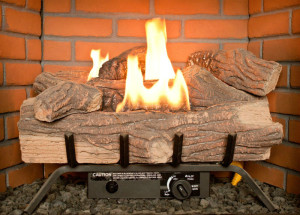What we’ve learned…..
Vent-free /Unvented gas logs usually require the damper to be closed. Some folks opt to just seal the throat of their fireplaces or the tops of their chimneys when these gas log systems are installed. Vent-free or unvented gas log appliances are somewhat controversial. There are some issues that have become evident in the last few years.

Firstly…..
There are several scenarios that can cause the system to emit low levels of carbon monoxide.
- Animal dander, pet hair, or dust on the burner
- flame impingement from the logs being positioned incorrectly
- air movement across burner
Any of these circumstances can cause the logs to burn at less than 100% efficiency and emit carbon monoxide. Since these systems are sometimes categorized as “room-vented” appliances, the issues they raise can cause concern.
- These low levels of carbon monoxide emission usually will not trigger your carbon monoxide detector, but are considered a health hazard.
- The instructions on the logs say not to install in a bedroom or to use if you are pregnant, have emphysema, or other respiratory problems.
If they are not healthy under these listed circumstances, perhaps there is cause for concern across the board.
Secondly…..
There is a concern about heat buildup in the firebox. Fireplaces are designed to flush most heat up into the flue. When logs are burned with the damper in the closed position or with the throat area completely sealed off, most of the heat is retained in the firebox. This causes the walls of the firebox or the breast area of the fireplace to become hotter than normal. Heat is then transferred through the firebox walls and into the wall cavity surrounding the fireplace.
If the builder did not observe proper clearances, or if framing lumber is in contact with the shell of the fireplace, pyrolization will occur. When the wood repeatedly heats and cools as the logs are used, this causes the flash point or ignition temperature of the wood to lower. Numerous home fires have been documented as starting in the walls, either next to or directly above the fireplace opening behind the mantle.
Thirdly……
Many times the incentive to get vent free gas logs is to produce more heat for the living area especially in the event of a power outage. Under these circumstances, the gas appliance may be operated for many hours without interruption. This can be a problem because many manufacturers’ instructions stipulate a limited operation time. Their specified time frame for operation insures that the levels of carbon monoxide that are emitted in the home are within the parameters considered nontoxic. If those time frames are exceeded, then the levels of emissions in the home may exceed safety standards.
Because of these concerns, vent-free gas logs are against code in some states (including California, Colorado, Wisconsin, Massachusetts) and the entire country of Canada. There are several websites that deal with carbon monoxide including www.coheadquarters.com and www.carbonmonoxidelawyer.com.
Our Recommendation
Our recommendation is to install vented or direct vent gas appliances. If vent free or unvented are chosen, we recommend a dual listed log set (one that can be operated with damper either open or closed) when installed in a wood burning fireplace/chimney. If strictly vent-free/unvented are installed, we encourage operators to be familiar with manufacturer’s operating instructions and follow them strictly for safest operation and best results. In all cases, we recommend that all gas appliances are regularly maintained and that carbon monoxide detectors are installed and checked regularly to make sure they are working.
Blue Sky Chimney Sweeps | Bless Your Hearth offers installation and service for gas logs, stoves, inserts and fireplaces.

